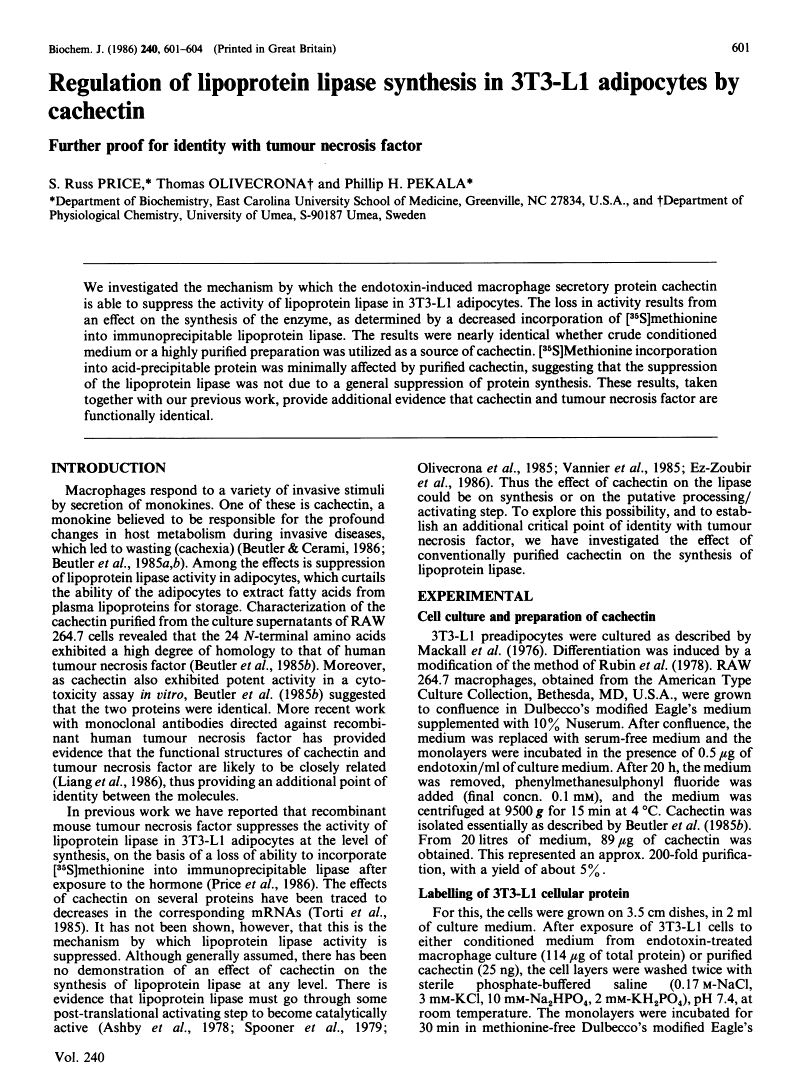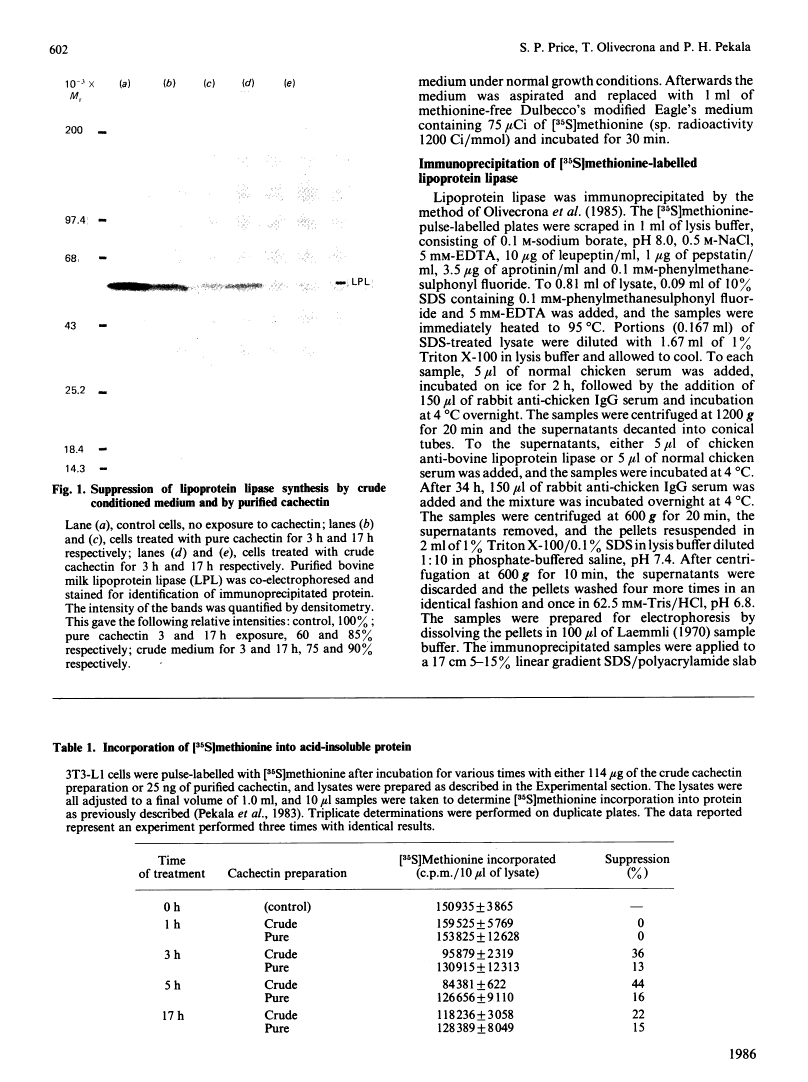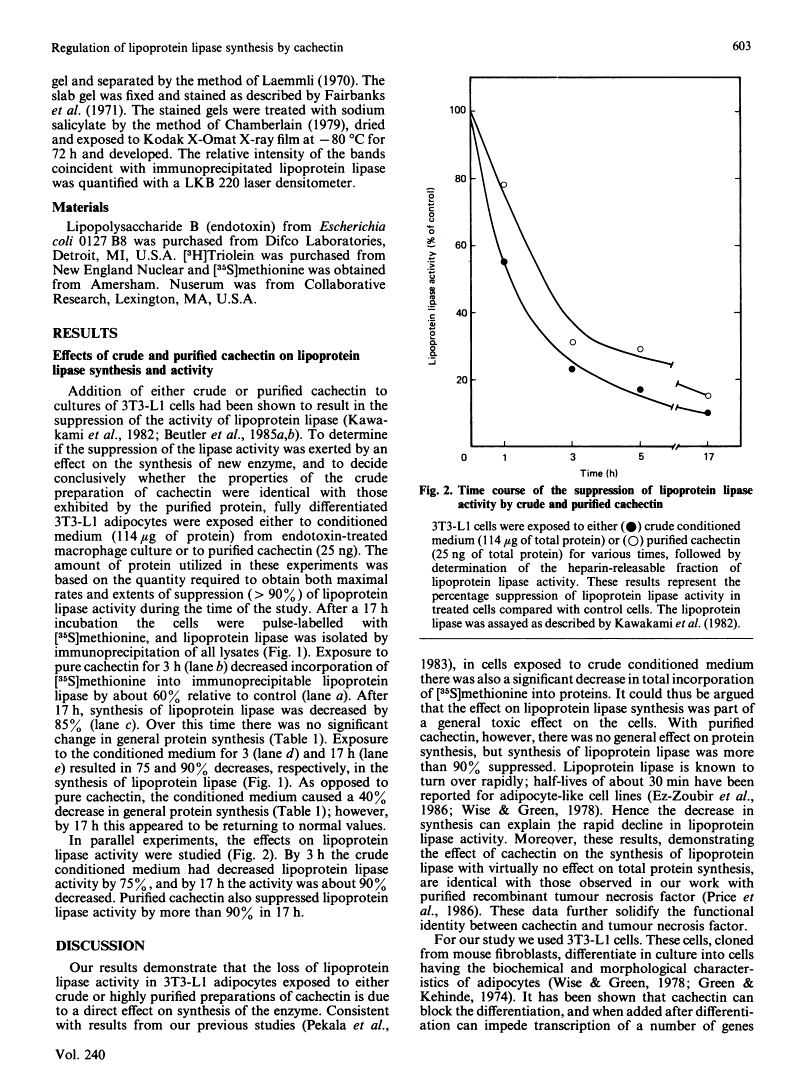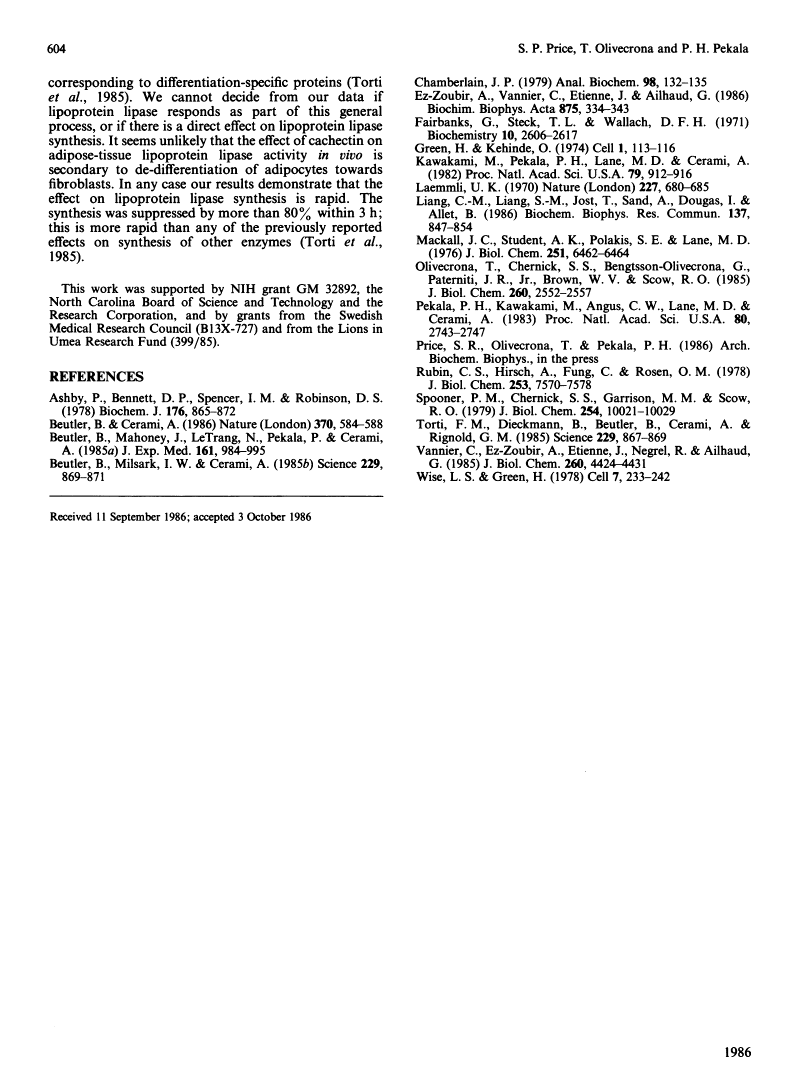Abstract
Free full text

Regulation of lipoprotein lipase synthesis in 3T3-L1 adipocytes by cachectin. Further proof for identity with tumour necrosis factor.
Abstract
We investigated the mechanism by which the endotoxin-induced macrophage secretory protein cachectin is able to suppress the activity of lipoprotein lipase in 3T3-L1 adipocytes. The loss in activity results from an effect on the synthesis of the enzyme, as determined by a decreased incorporation of [35S]methionine into immunoprecipitable lipoprotein lipase. The results were nearly identical whether crude conditioned medium or a highly purified preparation was utilized as a source of cachectin. [35S]Methionine incorporation into acid-precipitable protein was minimally affected by purified cachectin, suggesting that the suppression of the lipoprotein lipase was not due to a general suppression of protein synthesis. These results, taken together with our previous work, provide additional evidence that cachectin and tumour necrosis factor are functionally identical.
Full text
Full text is available as a scanned copy of the original print version. Get a printable copy (PDF file) of the complete article (937K), or click on a page image below to browse page by page. Links to PubMed are also available for Selected References.
Images in this article
Click on the image to see a larger version.
Selected References
These references are in PubMed. This may not be the complete list of references from this article.
- Ashby P, Bennett DP, Spencer IM, Robinson DS. Post-translational regulation of lipoprotein lipase activity in adipose tissue. Biochem J. 1978 Dec 15;176(3):865–872. [Europe PMC free article] [Abstract] [Google Scholar]
- Beutler B, Cerami A. Cachectin and tumour necrosis factor as two sides of the same biological coin. Nature. 1986 Apr 17;320(6063):584–588. [Abstract] [Google Scholar]
- Beutler B, Mahoney J, Le Trang N, Pekala P, Cerami A. Purification of cachectin, a lipoprotein lipase-suppressing hormone secreted by endotoxin-induced RAW 264.7 cells. J Exp Med. 1985 May 1;161(5):984–995. [Europe PMC free article] [Abstract] [Google Scholar]
- Beutler B, Milsark IW, Cerami AC. Passive immunization against cachectin/tumor necrosis factor protects mice from lethal effect of endotoxin. Science. 1985 Aug 30;229(4716):869–871. [Abstract] [Google Scholar]
- Chamberlain JP. Fluorographic detection of radioactivity in polyacrylamide gels with the water-soluble fluor, sodium salicylate. Anal Biochem. 1979 Sep 15;98(1):132–135. [Abstract] [Google Scholar]
- Amri EZ, Vannier C, Etienne J, Ailhaud G. Maturation and secretion of lipoprotein lipase in cultured adipose cells. II. Effects of tunicamycin on activation and secretion of the enzyme. Biochim Biophys Acta. 1986 Feb 12;875(2):334–343. [Abstract] [Google Scholar]
- Fairbanks G, Steck TL, Wallach DF. Electrophoretic analysis of the major polypeptides of the human erythrocyte membrane. Biochemistry. 1971 Jun 22;10(13):2606–2617. [Abstract] [Google Scholar]
- Kawakami M, Pekala PH, Lane MD, Cerami A. Lipoprotein lipase suppression in 3T3-L1 cells by an endotoxin-induced mediator from exudate cells. Proc Natl Acad Sci U S A. 1982 Feb;79(3):912–916. [Europe PMC free article] [Abstract] [Google Scholar]
- Laemmli UK. Cleavage of structural proteins during the assembly of the head of bacteriophage T4. Nature. 1970 Aug 15;227(5259):680–685. [Abstract] [Google Scholar]
- Liang CM, Liang SM, Jost T, Sand A, Dougas I, Allet B. Production and characterization of monoclonal antibodies against recombinant human tumor necrosis factor/cachectin. Biochem Biophys Res Commun. 1986 Jun 13;137(2):847–854. [Abstract] [Google Scholar]
- Mackall JC, Student AK, Polakis SE, Lane MD. Induction of lipogenesis during differentiation in a "preadipocyte" cell line. J Biol Chem. 1976 Oct 25;251(20):6462–6464. [Abstract] [Google Scholar]
- Olivecrona T, Chernick SS, Bengtsson-Olivecrona G, Paterniti JR, Jr, Brown WV, Scow RO. Combined lipase deficiency (cld/cld) in mice. Demonstration that an inactive form of lipoprotein lipase is synthesized. J Biol Chem. 1985 Feb 25;260(4):2552–2557. [Abstract] [Google Scholar]
- Pekala PH, Kawakami M, Angus CW, Lane MD, Cerami A. Selective inhibition of synthesis of enzymes for de novo fatty acid biosynthesis by an endotoxin-induced mediator from exudate cells. Proc Natl Acad Sci U S A. 1983 May;80(9):2743–2747. [Europe PMC free article] [Abstract] [Google Scholar]
- Rubin CS, Hirsch A, Fung C, Rosen OM. Development of hormone receptors and hormonal responsiveness in vitro. Insulin receptors and insulin sensitivity in the preadipocyte and adipocyte forms of 3T3-L1 cells. J Biol Chem. 1978 Oct 25;253(20):7570–7578. [Abstract] [Google Scholar]
- Spooner PM, Chernick SS, Garrison MM, Scow RO. Insulin regulation of lipoprotein lipase activity and release in 3T3-L1 adipocytes. Separation and dependence of hormonal effects on hexose metabolism and synthesis of RNA and protein. J Biol Chem. 1979 Oct 25;254(20):10021–10029. [Abstract] [Google Scholar]
- Torti FM, Dieckmann B, Beutler B, Cerami A, Ringold GM. A macrophage factor inhibits adipocyte gene expression: an in vitro model of cachexia. Science. 1985 Aug 30;229(4716):867–869. [Abstract] [Google Scholar]
- Vannier C, Amri EZ, Etienne J, Négrel R, Ailhaud G. Maturation and secretion of lipoprotein lipase in cultured adipose cells. I. Intracellular activation of the enzyme. J Biol Chem. 1985 Apr 10;260(7):4424–4431. [Abstract] [Google Scholar]
- Wise LS, Green H. Studies of lipoprotein lipase during the adipose conversion of 3T3 cells. Cell. 1978 Feb;13(2):233–242. [Abstract] [Google Scholar]
Associated Data
Articles from Biochemical Journal are provided here courtesy of The Biochemical Society
Full text links
Read article at publisher's site: https://doi.org/10.1042/bj2400601
Read article for free, from open access legal sources, via Unpaywall:
https://europepmc.org/articles/pmc1147456?pdf=render
Citations & impact
Impact metrics
Citations of article over time
Article citations
A decade of progress in adipose tissue macrophage biology.
Immunol Rev, 262(1):134-152, 01 Nov 2014
Cited by: 134 articles | PMID: 25319332 | PMCID: PMC4203421
Review Free full text in Europe PMC
Cancer cachexia prevention via physical exercise: molecular mechanisms.
J Cachexia Sarcopenia Muscle, 4(2):111-124, 13 Dec 2012
Cited by: 87 articles | PMID: 23239116 | PMCID: PMC3684702
Review Free full text in Europe PMC
Role of tumor necrosis factor-alpha gene locus in obesity and obesity-associated hypertension in French Canadians.
Hypertension, 36(1):14-19, 01 Jul 2000
Cited by: 46 articles | PMID: 10904006
Recombinant human tumour necrosis factor-alpha suppresses synthesis, activity and secretion of lipoprotein lipase in cultures of a human osteosarcoma cell line.
Biochem J, 316 ( Pt 3):813-817, 01 Jun 1996
Cited by: 5 articles | PMID: 8670156 | PMCID: PMC1217422
Interferon-gamma and interleukin-1 beta inhibit adipoconversion in cultured rodent preadipocytes.
J Cell Physiol, 151(2):300-309, 01 May 1992
Cited by: 41 articles | PMID: 1572904
Go to all (15) article citations
Data
Data behind the article
This data has been text mined from the article, or deposited into data resources.
BioStudies: supplemental material and supporting data
Similar Articles
To arrive at the top five similar articles we use a word-weighted algorithm to compare words from the Title and Abstract of each citation.
Regulation of lipoprotein lipase synthesis by recombinant tumor necrosis factor--the primary regulatory role of the hormone in 3T3-L1 adipocytes.
Arch Biochem Biophys, 251(2):738-746, 01 Dec 1986
Cited by: 65 articles | PMID: 3800396
Purification of cachectin, a lipoprotein lipase-suppressing hormone secreted by endotoxin-induced RAW 264.7 cells.
J Exp Med, 161(5):984-995, 01 May 1985
Cited by: 476 articles | PMID: 3872925 | PMCID: PMC2187615
Human recombinant TNF suppresses lipoprotein lipase activity and stimulates lipolysis in 3T3-L1 cells.
J Biochem, 101(2):331-338, 01 Feb 1987
Cited by: 106 articles | PMID: 3495531
Cachectin and tumour necrosis factor as two sides of the same biological coin.
Nature, 320(6063):584-588, 01 Apr 1986
Cited by: 962 articles | PMID: 3010124
Review









